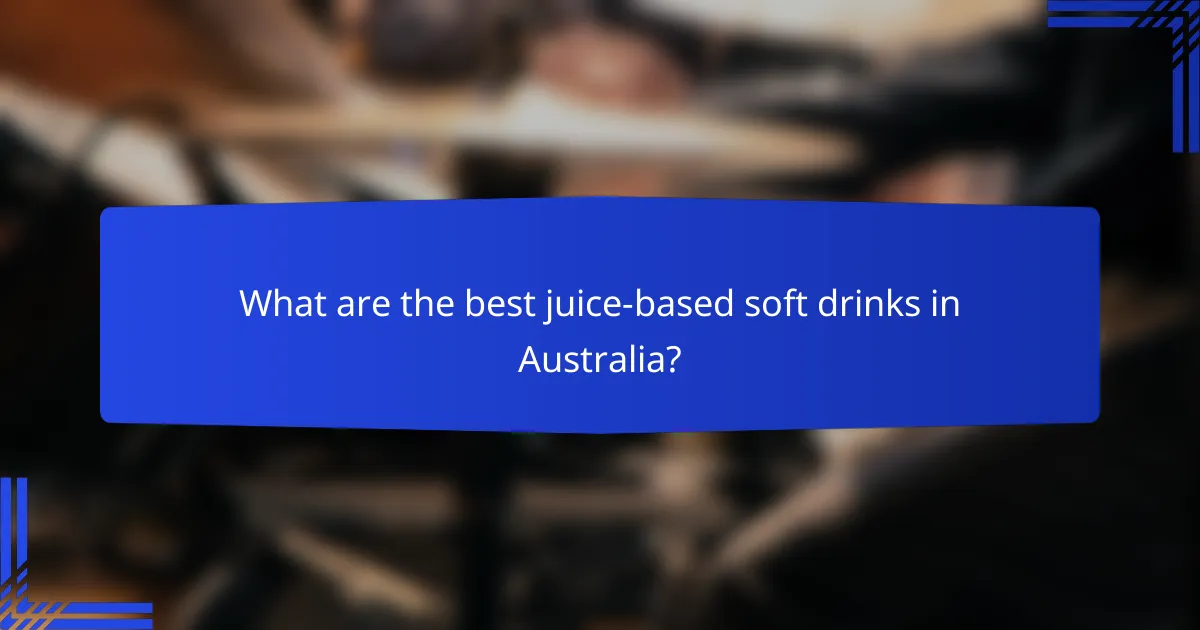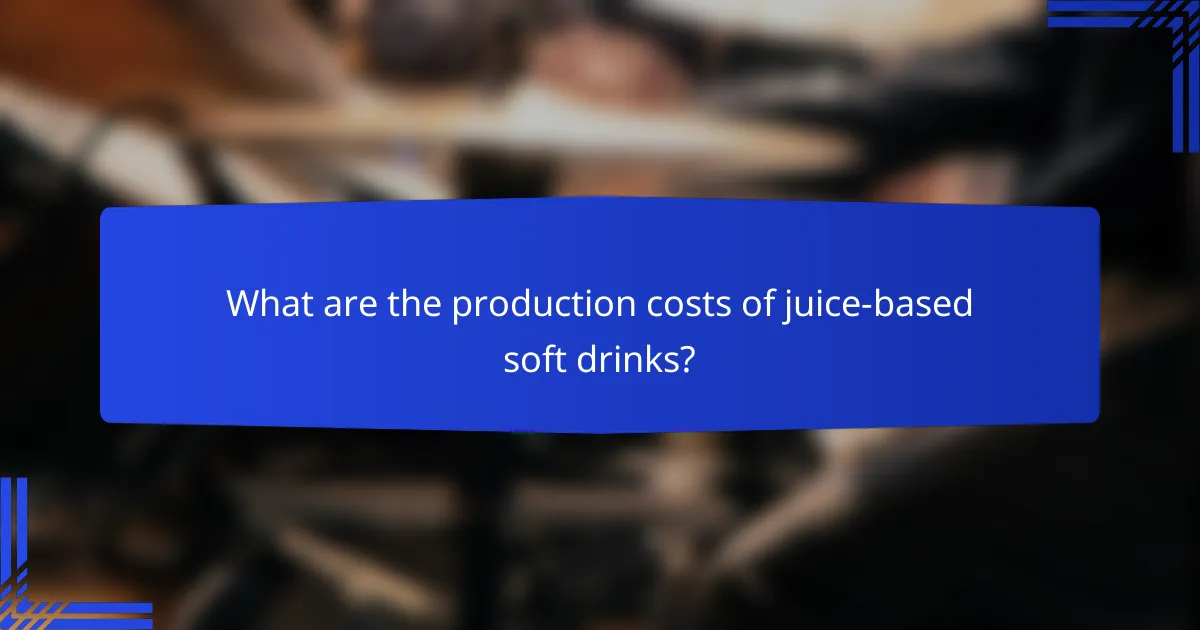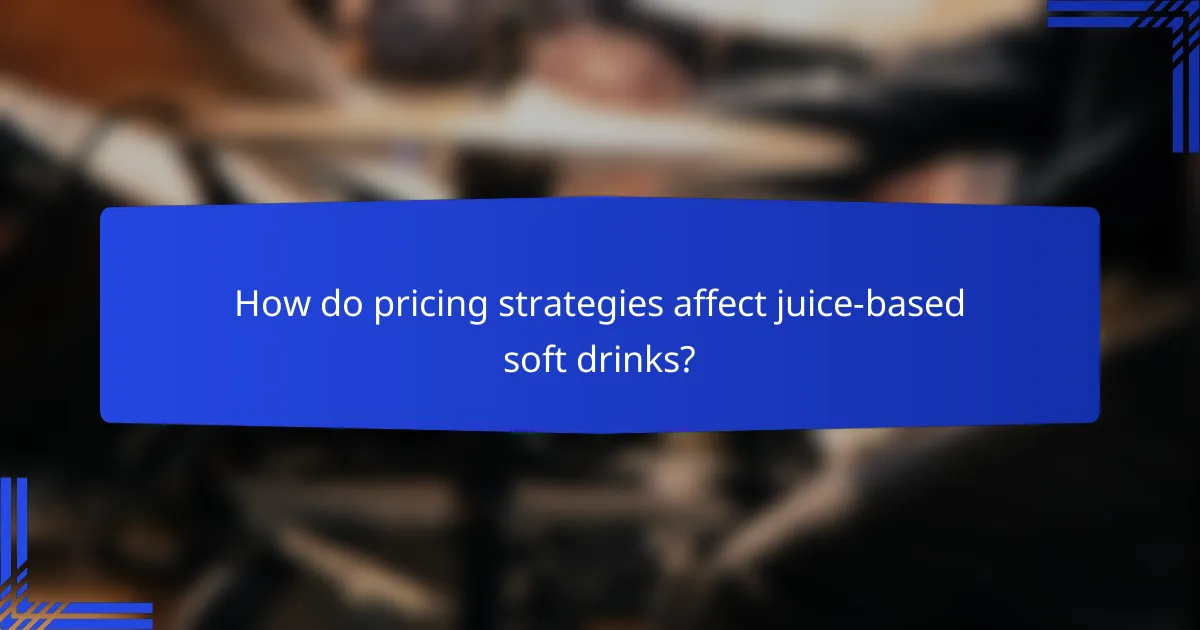Juice-based soft drinks have gained popularity for their refreshing taste and emphasis on fresh ingredients, appealing to health-conscious consumers. These beverages are crafted by extracting juice from fresh fruits and blending it with other components, ensuring quality through meticulous production methods. Understanding the production costs, including ingredient sourcing and packaging, is crucial for determining pricing and achieving profitability in this competitive market.

What are the best juice-based soft drinks in Australia?
The best juice-based soft drinks in Australia include a variety of refreshing options that emphasize fresh ingredients and unique flavors. Popular choices often feature blends of cold-pressed juices, sparkling fruit-infused beverages, and organic juice sodas, appealing to health-conscious consumers.
Cold-pressed juice blends
Cold-pressed juice blends are made by extracting juice from fruits and vegetables without heat, preserving more nutrients and flavor. These blends often combine ingredients like kale, apple, and ginger for a refreshing drink that is both tasty and nutritious.
When selecting cold-pressed juices, look for brands that use organic ingredients to avoid pesticides and additives. Prices typically range from AUD 5 to AUD 10 per bottle, depending on the brand and size.
Sparkling fruit-infused beverages
Sparkling fruit-infused beverages combine carbonated water with natural fruit flavors, providing a fizzy alternative to traditional soft drinks. These drinks often contain no added sugars and are a popular choice for those seeking a lighter, refreshing option.
In Australia, many brands offer unique flavor combinations, such as lemon-lime, berry blends, and tropical fruit mixes. Expect to pay around AUD 3 to AUD 6 for a can or bottle of these beverages.
Organic juice sodas
Organic juice sodas are carbonated drinks made with organic fruit juices and natural sweeteners, offering a healthier alternative to conventional sodas. These beverages typically contain fewer artificial ingredients and are often lower in sugar.
When choosing organic juice sodas, check for certifications to ensure the product meets organic standards. Prices generally range from AUD 4 to AUD 8 per bottle, reflecting the quality of the ingredients used.

How are juice-based soft drinks produced?
Juice-based soft drinks are produced by extracting juice from fresh fruits and blending it with other ingredients to create a refreshing beverage. The process involves careful sourcing of ingredients, specific production methods, and stringent quality control to ensure a high-quality final product.
Fresh ingredient sourcing
Sourcing fresh ingredients is crucial for producing high-quality juice-based soft drinks. Producers typically select ripe fruits that are in season to maximize flavor and nutritional value. Local sourcing can reduce transportation costs and ensure freshness, while organic options may appeal to health-conscious consumers.
Common fruits used include oranges, apples, and berries, but the choice often depends on regional availability and consumer preferences. Establishing relationships with local farmers can lead to better quality and more sustainable practices.
Production methods
The production of juice-based soft drinks generally involves several key steps: washing, juicing, blending, and carbonation if desired. After washing, fruits are juiced using either cold-press or traditional methods, with cold-pressing often yielding a higher quality juice.
Once juiced, the liquid may be blended with sweeteners, flavorings, or carbonation. The mixture is then pasteurized to eliminate harmful bacteria while preserving flavor. This process can vary in duration, typically taking a few minutes to ensure safety without compromising taste.
Quality control processes
Quality control is essential in the production of juice-based soft drinks to maintain consistency and safety. Producers often implement sensory evaluations, laboratory testing, and adherence to food safety regulations to monitor the quality of ingredients and the final product.
Regular checks for taste, color, and aroma help ensure that the drinks meet consumer expectations. Additionally, compliance with local regulations, such as those set by the FDA in the United States or EFSA in Europe, is critical for market acceptance and consumer trust.

What are the production costs of juice-based soft drinks?
The production costs of juice-based soft drinks involve several key components, including ingredient costs, packaging expenses, and labor and overhead. Understanding these factors is essential for pricing and profitability in the beverage industry.
Ingredient costs
Ingredient costs for juice-based soft drinks primarily include fresh fruits, vegetables, and any additional flavorings or sweeteners. Prices can vary significantly based on seasonality and sourcing; for instance, organic fruits may cost 20-50% more than conventional options.
When formulating a product, consider using local ingredients to reduce transportation costs and support local economies. This approach can also enhance marketing by emphasizing freshness and sustainability.
Packaging expenses
Packaging expenses encompass the materials used for bottles, labels, and caps, which can vary widely in cost. For example, glass bottles typically cost more than plastic alternatives, but they may appeal to a premium market segment.
Investing in eco-friendly packaging can attract environmentally conscious consumers, though it might increase initial costs. Balancing cost and consumer preferences is crucial for effective pricing strategies.
Labor and overhead
Labor and overhead costs include wages for production staff, utilities, and facility maintenance. These expenses can account for a significant portion of total production costs, often ranging from 20-30% of the overall budget.
Streamlining operations through automation or efficient scheduling can help reduce labor costs. Additionally, keeping overhead low by optimizing facility usage can improve overall profitability.

How do pricing strategies affect juice-based soft drinks?
Pricing strategies significantly influence the market success of juice-based soft drinks by determining their perceived value and competitiveness. Effective pricing can attract customers, enhance brand positioning, and ultimately drive sales while balancing production costs and profit margins.
Market positioning
Market positioning involves defining how a juice-based soft drink is perceived relative to competitors. Brands may choose to position their products as premium, organic, or budget-friendly, impacting pricing strategies. For instance, a premium juice brand may price its products higher to emphasize quality and freshness, appealing to health-conscious consumers willing to pay more.
Understanding target demographics is crucial in market positioning. For example, younger consumers may favor trendy, innovative flavors, while older demographics might prefer traditional, classic options. This knowledge helps in setting prices that align with consumer expectations and willingness to pay.
Competitive pricing analysis
Competitive pricing analysis involves examining the prices of similar juice-based soft drinks in the market to determine a suitable pricing strategy. Brands should consider factors such as ingredient quality, packaging, and distribution channels when comparing prices. A common approach is to price slightly below competitors to attract price-sensitive customers while maintaining perceived quality.
Regularly reviewing competitors’ pricing can help brands adjust their strategies in response to market changes. For example, if a competitor lowers their prices, a brand may need to evaluate its pricing to remain competitive without sacrificing profit margins.
Promotional pricing tactics
Promotional pricing tactics can effectively boost sales and market visibility for juice-based soft drinks. Common tactics include discounts, buy-one-get-one-free offers, and seasonal promotions. These strategies can create urgency and encourage trial among new customers, especially during peak sales periods like summer.
Brands should carefully plan promotional pricing to ensure it aligns with overall marketing goals. Overusing discounts can devalue the brand, so it’s essential to balance promotions with regular pricing to maintain perceived quality. Tracking the effectiveness of these promotions through sales data can inform future pricing strategies.

What are the health benefits of juice-based soft drinks?
Juice-based soft drinks offer several health benefits, primarily due to their natural ingredients and nutritional content. These beverages can provide essential vitamins and minerals while serving as a refreshing alternative to sugary sodas.
Nutritional advantages
Juice-based soft drinks often contain vitamins such as vitamin C, potassium, and antioxidants, which can support overall health. For instance, orange juice is known for its high vitamin C content, which can boost the immune system.
When selecting juice-based drinks, look for options that are labeled as “100% juice” to ensure you are getting the full nutritional benefits without added sugars. These beverages can contribute to your daily fruit intake, which is recommended to be around two servings per day.
Natural ingredients
Many juice-based soft drinks are made from real fruits and vegetables, making them a healthier choice compared to those with artificial flavors and preservatives. Ingredients like fresh berries, citrus fruits, and leafy greens not only enhance flavor but also provide natural sweetness and health benefits.
To maximize health benefits, choose brands that emphasize organic or locally sourced ingredients. This not only supports local agriculture but also reduces exposure to pesticides and chemicals commonly found in non-organic produce.
Hydration benefits
Juice-based soft drinks can contribute to hydration, especially when they are primarily water-based. The high water content in fruits helps replenish fluids, making these drinks a good option for staying hydrated throughout the day.
However, it’s essential to balance juice consumption with water intake. While juice can be hydrating, it should not replace plain water entirely. Aim for a mix of both to maintain optimal hydration levels, especially in warmer climates or during physical activity.

What trends are shaping the juice-based soft drink market in Australia?
The juice-based soft drink market in Australia is increasingly influenced by consumer preferences for organic ingredients, sustainability practices, and innovative flavor combinations. These trends reflect a growing demand for healthier and more environmentally friendly beverage options.
Increased demand for organic options
Consumers in Australia are gravitating towards juice-based soft drinks made from organic ingredients. This shift is driven by health-conscious individuals seeking products free from synthetic additives and pesticides. Brands that emphasize organic certification often see a boost in sales, as they appeal to this growing demographic.
To capitalize on this trend, manufacturers should consider sourcing organic fruits and vegetables and highlighting these ingredients on their labels. This can enhance brand loyalty and attract new customers who prioritize organic products.
Focus on sustainability
Sustainability is a key concern for Australian consumers, influencing their purchasing decisions in the juice-based soft drink sector. Brands that adopt eco-friendly practices, such as using recyclable packaging and reducing water consumption during production, are more likely to resonate with environmentally conscious buyers.
Implementing sustainable practices can also improve a company’s reputation and lead to cost savings in the long term. Companies should regularly communicate their sustainability efforts to consumers, as transparency can enhance trust and encourage repeat purchases.
Innovations in flavor profiles
Innovation in flavor profiles is transforming the juice-based soft drink market in Australia. Consumers are increasingly seeking unique and exotic flavors, moving beyond traditional options like orange and apple. This trend encourages brands to experiment with combinations such as turmeric-infused juices or blends featuring superfoods.
To stay competitive, companies should invest in research and development to explore new flavor combinations and seasonal offerings. Engaging with customers through taste tests or social media polls can also help identify popular flavors and foster a sense of community around the brand.
